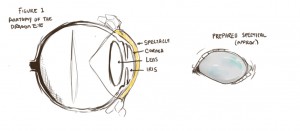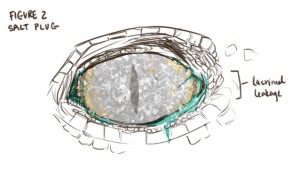A Practical Technique for Spectacle Removal in the Royal Dragon (Draco regius)
By Simonius Selvius, scholar-in-residence at the University of Heliopolis South, and Harun ibn Saleh Abd al-Bari, senior researcher at the University of the Nile, as provided by Sarah Frost
Art by Katie Nyborg
Introduction
The eyes of the dragon possess qualities unique in the animal kingdom. The seeing-scale, or spectacle, covering the dragon’s eye can, after being removed and treated, provide the wearer with extraordinary insight. Currently, the scarcity of these scales prevents their widespread use.
The spectacle forms a protective layer external to the cornea of the dragon’s eye. It consists of a keratinized layer that is shed with each molt. These structures are analogous to the scale-covered epidermis of basilisks and lesser reptiles. The subspectacular space is filled with tears (See Figure 1).
While Common Dragons (Draco parvus) have been domesticated successfully, the spectacles of these animals are too small to be of practical use. In contrast, the Royal Dragon (Draco regius) grows up to 18 hands high (6.6 chi) and possesses proportionally larger spectacles. However, the difficulties involved in maintaining such large and aggressive creatures puts them out of reach of most metafaunal collections, and precludes sacrificing these animals in sufficient numbers to make spectacle production economical.
The goal of this study was to demonstrate a novel method for removing the spectacle of a live Royal Dragon without sacrificing the animal, and to assess subsequent wound healing.
To read the rest of this story, check out the Mad Scientist Journal: Summer 2013 collection.
Simonius Selvius was born in Alexandria. He studied fauna and metafauna at the Confluential College of Mogran under the noted anatomist Leila El-Tahir. His thesis, “Antipyronic Bladders and Inflammable Fluids of the Royal Dragon” earned him laurels from the College of Mogran and his current post in the Metafaunal Department at the University of Heliopolis South.
Harun ibn Saleh Abd al-Bari has conducted numerous investigations into the properties of metafaunal tissue. Of particular note is his monograph on basilisk eyes and the problem of autotransmutation. His other works include “On the Gaze of the Basilisk and the Question of Petrifaction Versus Transmutation” and “Sensory Mediation of Vocalization Behavior in the Sirens of the Archipelago.”
Sarah Frost is a writer from Kansas whose mind has been warped by prolonged exposure to raw scientific research. Her work has appeared in Analog, Andromeda Spaceways Inflight Magazine, and Stupefying Stories, among others.
Katie Nyborg’s art, plus information regarding hiring her, can be found at http://katiedoesartthings.tumblr.com/
Follow us online:


